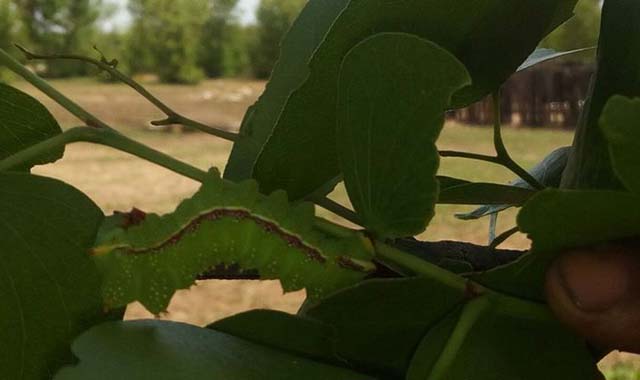Bulilima hit hard by macimbi extinction


The green amapipi macimbi are what is remaining due to over harvesting in Bulilima District
Sifelani Tsiko Syndication Writer
“KuBuKalanga ndiko kanyi kwedu, kwedu! KuBuKalanga ndiko kanyi kwedu! Hona chozanazana, chonanayila chondifungisa kanyi kwedu,” sings Eunice Sibanda as she leads a group of women singing the Kalanga theme song which celebrates the richness of their culture, identity and history.
The singing and the ululating that accompanies the song lights up the event to showcase their forestry garden at Hungwa Matiwaza Village in the Ndolwane Ward of Bulilima District, about 85km west of Plumtree border town.
The song is a great sign of welcome for visitors led by the Food and Agriculture Organisation (FAO) officials to the site.
The song: “KuBuKalanga ndiko kanyi kwedu” is a “national anthem” for the Kalanga speaking people in the Bulilima District in western Zimbabwe.
For Sibanda and other villagers in the Ndolwane Ward, the song urges them to take great pride in their land, culture and language.
The Bakalanga “national anthem,” she says, even torches the emotive natural resource issue.
“This is our land. All the trees, the insects, the animals and everything our ancestors survived on, belongs to us,” Sibanda says as she wades into the emotive macimbi delicacy issue.
“Tolumbidza lulimi nemilenje yedu namashonja edu. (We celebrate our language and culture including our macimbi/madora delicacy).”
Deep inside Bulilima District, massive deforestation and the illegal over-harvesting of the popular amacimbi delicacy (commonly referred by forestry experts as caterpillars/ Emperor Moth/Gonimbrasia belina) in the past decade has left the local community reeling.
Since time immemorial, the edible macimbi delicacy widely consumed in Zimbabwe and most other Southern African countries provided food at low cost and generated income for locals, helping to fight hunger and poverty.
Amacimbi or mashonja in Kalanga constituted one of the cheapest sources of animal protein for locals
For a long time, locals collected mashonja from the wild and partly traded them to earn money to buy other needs.
“Mashonja are all gone now,” she says.
“At the height of the economic crisis around 2008, people came from as far as Harare to harvest mashonja. We were powerless and we couldn’t stop them. The harvesting was vicious and it depleted our mashonja. What remains are amapipi — the green type of amacimbi, which is less popular. The black ones are all gone. You hardly get a good harvest these days.”
Sibanda and other locals are still angry at damaging consequences of over-harvesting amacimbi.
The extinction of amacimbi has left them in a pit of poverty.
“Sibanda and other villagers voice concern, saying the level of threat to amacimbi was much greater than previously thought.
“For many years amacimbi provided us a source of food and nutrition,” she says.
“We also earned some income from selling the delicacy. Now everything is gone. We now look at ourselves with shame. We should never have allowed this (over-harvesting) to happen.”
Fortunes Mathuthu, a Forestry Commission district officer for Bulilima says unsustainable harvesting practices have decimated amacimbi species in the area.
“When you go across the border into Botswana, the species are still in abundance but on the Zimbabwean side there is nothing,” he says.
“All this is because of our unsustainable harvesting practices. Poverty is really driving up the extinction of amacimbi. People catch the worms whilst they are still young and when they go into hibernation, they dig them up, leading to a massive decline of the amacimbi population.”
Climate change has also added to the woes.
In years gone, locals could harvest them in large quantities during the early months of the rainy season (November to January) and get another smaller second harvest in the April-May period following good rains. But now with the frequency of droughts and human interference, amacimbi populations have declined significantly.
Forestry experts say their population vary from year to year based on the availability of rainfall and presence of host tree leaves.
They say the preferred time for harvesting the larvae is when they are in the 5th larval stage, just before pupation.
Amacimbi feed on the leaves of the mopane tree (colophospermum mopane), which is found in the south and western parts of Zimbabwe, stretching into parts of South Africa, Zambia, Botswana and northern Namibia.
Amacimbi are found over a fairly large area in Zimbabwe. The areas include parts of Chivi, Mwenezi, Mberengwa, Beitbridge, Chiredzi and Gwanda.
“Commercialisation and a sharp appetite among urbanites has decimated the amacimbi populations,” says Mathuthu.
“People were now coming from far flung places to harvest amacimbi without following local customs and traditions. This led to over-harvesting and extinction of amacimbi. The local Kalanga people had cultural practices that safeguarded amacimbi populations. Before they could harvest, locals would take amacimbi to the Manyangwa sacred shrine for thanksgiving, after that, people would then be allowed to go and harvest. This was a sustainable practice that made amacimbi populations to thrive.”
This ceremony was held to worship and seek guidance from the spirits and nature and formed an important part of the Kalanga religion and culture.
The Kalanga people in years gone by placed high value on respecting the environment and its natural resources. But commercialisation has threatened their way of life.
Most rural households no longer have income generated from amacimbi to buy food and pay school fees.
“The heavy presence of people from far-away places, the high rate of deforestation and commercialisation has increased in the past decade, leading to over harvesting of amacimbi,” says Mathuthu.
“The people who came had no respect for local traditions. They only saw amacimbi and the dollar sign, whereas locals would wait for amacimbi to mature and for others to drop to the ground for the next cycle.”
The black type of amacimbi are now found in small pockets in the Makorokoro area of Mangwe District, Makhado in Beitbridge and the Mabhongwane forestry area in Bulilima District.
For most areas, there only remain amapipi (the green ones), which are less favoured on the market.
“Amacimbi have now become extinct in the district,” says Rickson Matengarufu, a forestry project officer for Practical Action.
“This is due to over-harvesting. Macimbi normally have their own life cycle and when it’s disrupted, it affects their numbers. When the drought is severe, people even eat cacoons of amacimbi, speeding up their extinction.”
Deforestation and over-harvesting of amacimbi has made the traditional way of life difficult to maintain for locals.
FAO in partnership with Practical Action and the Forestry Commission are working with local communities on re-afforestation projects in the Mangwe and Bulilima districts. They are educating people about the importance of conserving trees and amacimbi, since over-harvesting may result in extinction.
Forestry officers and locals also discuss how the amacimbi trade works and how it should be regulated to build up amacimbi populations.
Under the programme, the local community are also being trained on how they could possible embark on amacimbi farming — a semi-wild practice which includes all stages from egg to adult moth production in a protected and monitored environment.
Zimbabwe is a signatory to international agreements, such as the Convention on International Trade in Endangered Species of Wild Fauna and Flora (Cites) and environmentalists say it is important to use such instruments to try and curb over-harvesting and illegal trade in amacimbi.
“There are some regulatory aspects that can be borrowed from Cites, such as finding ways of issuing permits or to empower locals to harvest amacimbi in a sustainable way,” says an environmentalist.
“The other thing that would really help build up amacimbi populations would be to raise awareness of the importance of harvesting sustainably, because in many cases amacimbi are not destined for international markets. They are just traded in local markets, so many local communities need to be aware of how they should harvest them or if they should harvest them at all.” — Zimpapers Syndication








Comments